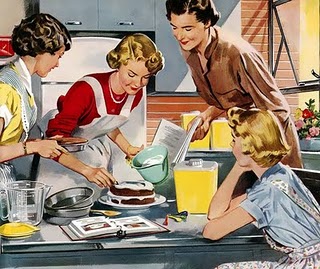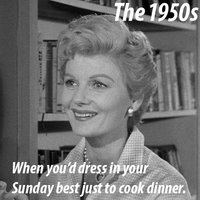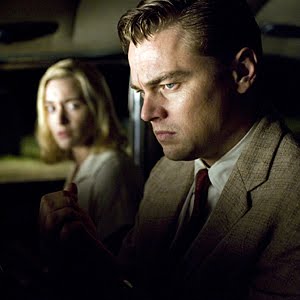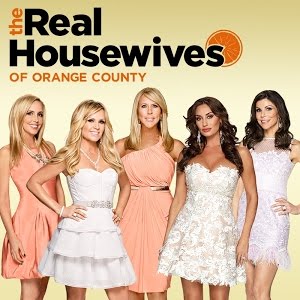The first question to ask ourselves is what exactly is the domestic ideal? It’s a question that should be answered and to put it lightly here is a poem straight from “To the Bride,” a cookbook/homemaking manual that was published in 1956,
The way to a man’s heart
So we’ve been told,
Is a good working knowledge
Of pot, pan, and mold
The talented gal
Who can whip up a pie,
Rates a well deserved rave
From her favorite guy
A juicy red steak
Or a tender, fish fillet
Done to a turn
In a bright copper skillet
Will soothe the rough edges
Of tempers, no fooling!!!
And leave the man happy
Contented and drooling
Essentially, the 1950s domestic ideal limited women’s roles to those of wife, mother, and homemaker. This ideology is vividly illustrated in these lines. The 1950s in many ways was a repressive time for women, and though there are few exceptions, most women were put into this category of being a homemaker, wife and mother. The postwar period expanded this ideal of the domestic role of women and the new emergence of consumerism made it more possible to target to women through media, and to reinforce this gender stereotype of a woman being simply a “housewife” and nothing more.
 Cookbooks are an example of how popular culture from the 1950s reflected a deep ambivalence Americans felt about the gender roles in the postwar years (Neuhaus 531). Also a time of very complacent and developing gender norms. During WWII, the cookbooks published reflected a cultural need to reaffirm women’s traditional roles, which reiterated that a woman’s place was in the kitchen. As “Betty Crocker” put it women remained “first and foremost, homemakers”(Neuhaus 532). Though realities for women may have changed during the war, the domestic ideal of womanhood had not. And war time deprivations begin to set the stage for what was to come during the postwar period.
Cookbooks are an example of how popular culture from the 1950s reflected a deep ambivalence Americans felt about the gender roles in the postwar years (Neuhaus 531). Also a time of very complacent and developing gender norms. During WWII, the cookbooks published reflected a cultural need to reaffirm women’s traditional roles, which reiterated that a woman’s place was in the kitchen. As “Betty Crocker” put it women remained “first and foremost, homemakers”(Neuhaus 532). Though realities for women may have changed during the war, the domestic ideal of womanhood had not. And war time deprivations begin to set the stage for what was to come during the postwar period.
Americans were in need of comfort food in the 1950s and with new developments in manufacturing and producing, the homogenization of cuisine was yet another aspect of postwar abundance and the new modern age. Comfort food then became not only a war-weary right, but a patriotic privilege. And with this women were expected to become more creative with the food they created and made. Cookbooks encouraged women to throw “Hawaiian company dinners” or “country style” meal (Neuhaus 533). Thus, advertisements began to appeal to women who were trying to keep up with this new domestic goal that they needed to “present” a meal and to not merely just “cook” it. Cookbooks tried to appeal to women by presenting representations of “traditional” women compeletly fulfilled by their roles as devoted and nurturing mother, which spoke to the desires and expectations of society, since more women were trying to seek employment outside the home and seeking other civic duties.
 These cookbooks also maintained that a woman’s role demanded a cheerful acceptance of the inescapable and that she must learn to cook without complaint. The recipes within these books reiterated gender norms, by either sexualizing the process of cooking, i.e. : “the way to a man’s heart is through his stomach” or by gendering certain cooking processes or types of behavior, linking masculinity to meat preparation and barbecuing. They even went so far to show cooking as a desirable trait and that it would make one more attractive to the opposite sex, this was done by linking culinary skills to popularity. Essentially a woman’s job was never done. She must keep up her culinary skills to remain attractive to her husband, and not only with the cooking, but also the cleaning, and on top of that she must keep up her appearance. It is a whole medley of things that a woman must maintain in her daily life to appease not only her husband, but also society, because it is not necessarily what she wants to do, but rather what’s expected of her.
These cookbooks also maintained that a woman’s role demanded a cheerful acceptance of the inescapable and that she must learn to cook without complaint. The recipes within these books reiterated gender norms, by either sexualizing the process of cooking, i.e. : “the way to a man’s heart is through his stomach” or by gendering certain cooking processes or types of behavior, linking masculinity to meat preparation and barbecuing. They even went so far to show cooking as a desirable trait and that it would make one more attractive to the opposite sex, this was done by linking culinary skills to popularity. Essentially a woman’s job was never done. She must keep up her culinary skills to remain attractive to her husband, and not only with the cooking, but also the cleaning, and on top of that she must keep up her appearance. It is a whole medley of things that a woman must maintain in her daily life to appease not only her husband, but also society, because it is not necessarily what she wants to do, but rather what’s expected of her.
 No matter what, there are always going to be struggles and debate when it comes to gender roles and norms. As much as I would like to believe that there will be a time when men and women are equal in all aspects, not just the workforce, I believe that it is a far off distance dream, one with no reality. Women will continually be put into the domestic sphere, no matter how hard we may try to escape because it has become something normative. And though the face and look of the modern day housewife may have changed since the 1950s, those ideals and the principles that came about in that era still remain, and certain aspects have just gotten worse.
No matter what, there are always going to be struggles and debate when it comes to gender roles and norms. As much as I would like to believe that there will be a time when men and women are equal in all aspects, not just the workforce, I believe that it is a far off distance dream, one with no reality. Women will continually be put into the domestic sphere, no matter how hard we may try to escape because it has become something normative. And though the face and look of the modern day housewife may have changed since the 1950s, those ideals and the principles that came about in that era still remain, and certain aspects have just gotten worse.




















